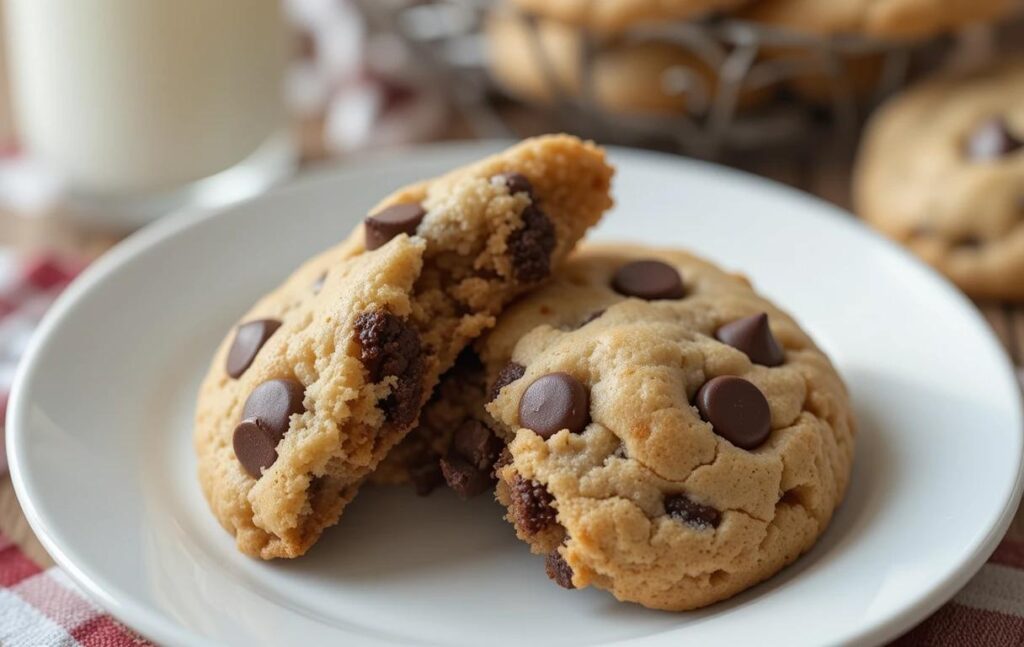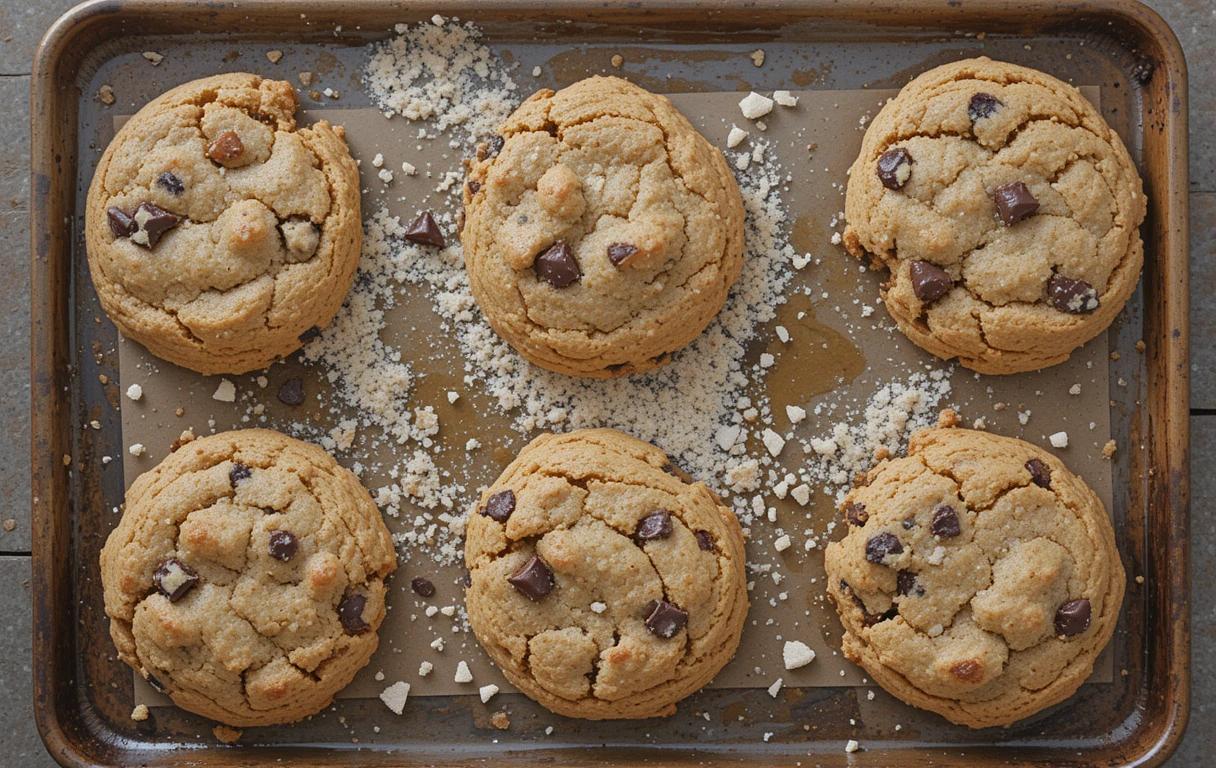Introduction to Chocolate Chip Cookie Recipe Without Brown Sugar
Chocolate Chip Cookie Recipe Without Brown Sugar are a timeless treat, loved for their chewy texture, golden edges, and rich, melty chocolate. While most traditional recipes call for brown sugar to provide a hint of molasses flavor and a soft texture, you can still bake delightful chocolate chip cookies without it. This recipe offers a simple and delicious alternative, using granulated sugar as the primary sweetener. The result is a crispier, lighter cookie with all the chocolatey goodness you crave. Whether you’re out of brown sugar or prefer a different taste, this recipe ensures you won’t miss out on your favorite homemade cookies.
Why This Recipe Works: Benefits of Using White Sugar Only
This recipe is a fantastic alternative to traditional chocolate chip cookies because it leverages the unique properties of white sugar. Here’s why it works and the benefits of using only white sugar:
- Crispier Texture
White sugar doesn’t contain molasses, unlike brown sugar. As a result, it promotes spreading and caramelization during baking, giving the cookies a delightful crisp edge. - Milder Sweetness
White sugar provides a cleaner, more neutral sweetness, which allows the flavors of butter and chocolate to shine more prominently. - Simplified Ingredients
Using only white sugar makes the recipe straightforward and accessible, especially when you don’t have brown sugar on hand. - Golden-Brown Finish
White sugar caramelizes at a slightly higher temperature, contributing to a beautiful golden-brown color without the denser texture that brown sugar can create. - Versatility
This recipe can easily be adjusted for flavor preferences. Adding a touch of vanilla extract or even a pinch of cinnamon enhances the sweetness and aroma while maintaining the simplicity of using just white sugar.
By relying solely on white sugar, this recipe delivers a distinct variation of the classic cookie that is crisp, buttery, and deliciously chocolate-filled.
Ingredients Overview: Chocolate Chip Cookies Without Brown Sugar
Here’s a breakdown of the ingredients, their roles, and tips for substituting brown sugar while maintaining the right proportions:
Essential Ingredients
- All-Purpose Flour
- Forms the structure of the cookies.
- Proportion Tip: Use the exact measurement to avoid cookies being too dense or too crumbly.
- White Granulated Sugar
- Adds sweetness and promotes crispiness.
- Substitute for Brown Sugar: White sugar works perfectly on its own in this recipe. If you want to mimic brown sugar’s slight molasses flavor, you can mix 1 tablespoon of molasses or honey into every cup of white sugar used.
- Butter (Unsalted or Salted)
- Provides richness and contributes to the cookie’s tender crumb.
- Proportion Tip: Ensure butter is softened for even mixing and to achieve the right texture.
- Eggs
- Bind the ingredients together and add moisture.
- Proportion Tip: Stick to the recipe’s egg count, as too many eggs can make the dough overly sticky.
- Vanilla Extract
- Enhances the flavor with its warm, sweet aroma.
- Optional: You can experiment with almond extract or omit entirely if unavailable.
- Baking Soda or Baking Powder
- Leavens the cookies, helping them rise and spread.
- Proportion Tip: Accurate measurement is critical to avoid overly flat or dense cookies.
- Salt
- Balances sweetness and enhances the flavors of the other ingredients.
- Optional Adjustment: Skip if using salted butter.
- Chocolate Chips or Chunks
- The star ingredient that gives the cookies their iconic appeal.
- Substitute: Use white chocolate, dark chocolate, or any mix-ins like nuts or dried fruit.
Substitutes for Brown Sugar
- White Sugar with Molasses: Blend 1 cup of white sugar with 1 tablespoon of molasses to replicate brown sugar.
- Honey or Maple Syrup: Use ¾ cup for every cup of sugar; reduce other liquid ingredients slightly.
- Coconut Sugar: Offers a rich, caramel-like flavor.
Importance of Proportions
- Baking is a science; precise measurements ensure the proper texture, taste, and appearance.
- Altering sugar proportions can change the cookies’ sweetness, spread, and texture.
- Balancing wet and dry ingredients (e.g., butter and flour) is crucial for dough consistency. Too much liquid results in overly spread-out cookies, while too much dry ingredient makes them crumbly.
Mastering proportions and understanding ingredient roles will help you bake perfect cookies, even without brown sugar!
Step-by-Step Instructions: Chocolate Chip Cookies Without Brown Sugar

Here’s a detailed guide to prepare delicious cookies without brown sugar, along with tips to ensure success:
1. Preheat the Oven
- Set Temperature: Preheat your oven to 350°F (175°C).
- Tip: Preheating ensures even baking. Use an oven thermometer for accuracy if possible.
2. Prepare the Baking Sheet
- Line the Tray: Use parchment paper or a silicone baking mat to prevent sticking.
- Tip: Avoid greasing the tray as it may cause excessive spreading.
3. Gather Ingredients
- Measure out all your ingredients:
- 2 ¼ cups all-purpose flour
- 1 teaspoon baking soda
- ½ teaspoon salt
- 1 cup (2 sticks) unsalted butter, softened
- 1 cup granulated sugar
- 2 large eggs
- 2 teaspoons vanilla extract
- 2 cups chocolate chips
- Tip: Use room-temperature butter and eggs for easier mixing and better texture.
4. Mix Dry Ingredients
- In a medium bowl, whisk together flour, baking soda, and salt.
- Tip: Sifting the dry ingredients ensures even distribution and prevents clumps.
5. Cream Butter and Sugar
- In a large bowl, use an electric mixer to beat the softened butter and sugar until light and fluffy (about 2-3 minutes).
- Tip: Proper creaming creates air pockets, resulting in a better rise and texture.
6. Add Eggs and Vanilla
- Beat in the eggs one at a time, mixing thoroughly after each addition. Then add the vanilla extract.
- Tip: Avoid overmixing at this stage to prevent a dense texture.
7. Combine Wet and Dry Ingredients
- Gradually add the dry ingredients to the wet mixture, mixing on low speed or by hand until just combined.
- Tip: Overmixing activates gluten in the flour, leading to tough cookies.
8. Fold in Chocolate Chips
- Use a spatula to gently fold in the chocolate chips.
- Tip: Reserve a few chips to press into the tops of the cookies before baking for a bakery-style look.
9. Portion the Dough
- Use a cookie scoop or tablespoon to drop evenly sized mounds of dough onto the prepared baking sheet, spacing them about 2 inches apart.
- Tip: For uniform cookies, roll dough balls between your palms.
10. Bake
- Bake in the preheated oven for 10-12 minutes, or until the edges are golden brown and the centers look slightly undercooked.
- Tip: Cookies continue to cook slightly on the baking sheet after being removed from the oven.
11. Cool
- Let the cookies cool on the baking sheet for 5 minutes, then transfer them to a wire rack to cool completely.
- Tip: Cooling on a rack prevents overbaking and keeps the bottoms from becoming soggy.
Tips for Success
- Chill the Dough (Optional): If your dough feels too soft, chill it for 30 minutes to prevent excessive spreading.
- Adjust Baking Time: For chewier cookies, bake slightly less; for crispier cookies, bake slightly longer.
- Storage: Store cooled cookies in an airtight container for up to 1 week, or freeze for longer storage.
Enjoy your perfectly golden, chocolate-filled cookies!
White Sugar vs. Brown Sugar: Comparison in Cookies

The type of sugar used in cookies plays a critical role in their texture, flavor, and appearance. Here’s a detailed comparison between white and brown sugar and how they affect your cookies:
1. Texture
- White Sugar
- Produces cookies with a crispier texture, especially around the edges.
- Encourages more spreading during baking due to its lower moisture content.
- Results in a thinner, crunchier cookie overall.
- Brown Sugar
- Creates softer, chewier cookies.
- Contains molasses, which adds moisture and makes the dough more pliable.
- Results in a denser cookie with a fudgy center.
2. Flavor
- White Sugar
- Offers a neutral, clean sweetness.
- Allows other flavors, such as vanilla and chocolate, to stand out more prominently.
- Lacks the subtle caramel undertones that brown sugar provides.
- Brown Sugar
- Provides a rich, complex sweetness with molasses notes.
- Adds depth of flavor and a hint of caramel or toffee-like taste.
- Enhances the overall richness of the cookies.
3. Appearance
- White Sugar
- Leads to cookies with a lighter color and a golden, even surface.
- Promotes caramelization, giving cookies a crisp finish but without the darker hue of brown sugar.
- Brown Sugar
- Produces cookies with a darker, richer appearance due to the molasses content.
- The higher moisture can lead to a puffier, slightly less spread-out look.
Conclusion: Choosing the Right Sugar
- Use white sugar for crisp, light-colored cookies with a clean and simple sweetness. Perfect for recipes where you want a subtle flavor or crisp texture.
- Use brown sugar for rich, chewy cookies with deep molasses undertones. Great for recipes emphasizing flavor complexity and moisture.
Both types can be used together for the best of both worlds: a balanced cookie with chewy centers and crisp edges!
Tips for Perfect Cookies Without Brown Sugar

Baking cookies without brown sugar doesn’t mean compromising on flavor or texture. Here are tips to adjust sweetness and achieve the ideal cookie texture:
1. Adjusting Sweetness
- Use White Sugar Strategically
- White sugar is less sweet than brown sugar due to the absence of molasses. If you prefer sweeter cookies, increase the sugar by 1-2 tablespoons without altering the recipe balance.
- Enhance with Natural Sweeteners
- Add a tablespoon of honey, maple syrup, or molasses to replicate the richness of brown sugar. Reduce other liquid ingredients slightly to maintain the dough’s consistency.
- Experiment with Vanilla
- Increasing the vanilla extract by ½ teaspoon enhances the perceived sweetness and depth of flavor.
- Mix in Sweet Additions
- Incorporate white chocolate chips, dried fruits, or sweetened coconut flakes for a natural boost in sweetness.
2. Achieving the Ideal Texture
- For Chewy Cookies
- Chill the Dough: Refrigerate the dough for 30 minutes before baking. This slows spreading and gives cookies a denser, chewier texture.
- Add a Yolk: Use one whole egg and an extra yolk instead of two whole eggs. The yolk adds richness and chewiness.
- For Crisp Cookies
- Spread Encouragement: Use melted butter instead of softened butter, and press the dough balls slightly flat before baking.
- Reduce Moisture: Avoid adding molasses or other liquid ingredients, as they make the cookies softer.
- For Balanced Texture
- Use a combination of room-temperature butter and granulated sugar to create cookies that are crisp on the edges and soft in the middle.
- Bake until the edges are golden but the centers look slightly underdone. They will firm up as they cool.
3. Baking and Handling Tips
- Precision in Measuring
- Baking is a science; measure ingredients carefully to avoid imbalances that can affect texture.
- Even Spacing
- Space cookie dough at least 2 inches apart to prevent overcrowding and ensure even baking.
- Rotate the Baking Sheet
- Halfway through baking, rotate the sheet for uniform heat distribution.
- Cool Properly
- Let cookies cool on the baking sheet for 5 minutes before transferring them to a wire rack. This prevents breakage and sogginess.
4. Experiment and Customize
- Add textures like nuts or oats for chewiness.
- Sprinkle sea salt on top before baking to enhance flavors and add contrast.
By fine-tuning sweetness and adopting these texture-enhancing techniques, you can bake cookies without brown sugar that are just as delightful as the classic version!
Frequently Asked Questions (FAQs)
1. Common Issues and Solutions
- Why are my cookies spreading too much?
- This could be due to overly soft butter or a warm dough. Chill the dough for 30 minutes before baking to prevent excessive spreading.
- Why are my cookies dry or crumbly?
- Over-measuring flour or overbaking can lead to dry cookies. Ensure precise measurements and bake only until the edges are golden.
- Why do my cookies taste bland?
- Enhance the flavor by increasing vanilla extract slightly or adding a pinch of salt to balance the sweetness.
- Why didn’t my cookies rise properly?
- Check that your baking soda or powder is fresh. Expired leavening agents won’t provide the necessary lift.
2. Storage Tips
- Short-Term Storage
- Store cookies in an airtight container at room temperature for up to 1 week. Place a slice of bread in the container to maintain softness.
- Long-Term Storage
- Freeze baked cookies in a sealed container or freezer bag for up to 3 months. Separate layers with parchment paper to prevent sticking.
- Freezing Dough
- Scoop dough into balls and freeze on a baking sheet. Once frozen, transfer to a freezer bag. Bake directly from frozen, adding 1-2 minutes to the baking time.
3. Reheating Techniques
- Microwave
- Warm a cookie on medium power for 10-15 seconds to restore softness.
- Oven
- Preheat the oven to 300°F (150°C) and heat cookies on a baking sheet for 3-5 minutes to refresh their texture.
- Toaster Oven
- Heat cookies at a low setting for a few minutes to restore crisp edges and a warm center.
Who Invented the Chocolate Chip Cookie?
Conclusion
This chocolate chip cookie recipe without brown sugar proves that simplicity and versatility can yield delicious results. By using white sugar, you achieve crisp edges, a lighter texture, and a clean sweetness that lets the chocolate shine. With easy-to-follow steps, readily available ingredients, and adaptable techniques, this recipe is perfect for novice bakers and seasoned pros alike. Whether you’re baking for a special occasion or simply to satisfy a sweet tooth, these cookies are sure to become a household favorite.
Related Recipes
- “Tuna Tomato Sauce Pasta Recipe“: A tomato-based recipe showcasing another way to use tomatoes.
- “Baked Chicken Fettuccine Alfredo with Broccoli“: Another comforting dish that can be complemented with tomato-based sauces.
Ingredient-Focused Content
- “Lions Mane Mushroom Recipe“: Suggest using a tomato gravy as a flavorful addition for plant-based dishes.
Cooking Techniques and Enhancements
- “Mango Habanero Salsa“: Explore complementary uses of sauces and gravies for flavor diversity.
Storage and Reuse Tips
- “Sous Vide Recipes“: Recommend tomato gravy as a sauce for sous vide-cooked meats or vegetables.
- “Ocean Spray Cranberry Sauce Recipe“: Guide readers on making and storing sauces, including tomato gravy.

